The answer was a rescue mission. The effort, afflicted by rushed planning and poor intelligence, was chaotic. The US didn’t know where the communists were holding the Mayaguez crew. Airmen and marines sent into battle found an enemy force much larger than anticipated. They faced withering fire from an entrenched enemy. Moreover, the Air Force helicopter crews were compelled to carry out a mission for which they had no formal training.
The ship and its crew were recovered, but the cost—in lost service lives and damaged equipment—was high.
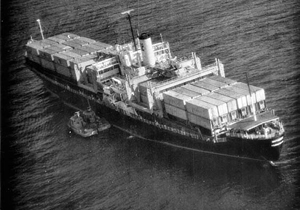 |
Two Khmer Rouge gunboats are seen during seizure of the US container ship |
A Mayday distress signal from the Mayaguez radio operator guided a Navy P-3 patrol aircraft to the vessel the morning after it was seized. The ship was riding at anchor about 34 miles from the Cambodian harbor town of Kompong Som, near a spit of land called Tang Island—Koh Tang, in Khmer.
While the US kept up its airborne watch on the ship, President Gerald Ford and his advisors decided to mount a swift rescue operation. The goal was to keep the ship’s 39 crewmen from being transferred to the mainland. They were haunted by North Korea’s 1968 seizure of USS Pueblo and its Navy crew members, who were held for 11 months.
The US had no formal relations with the new communist dictatorship in Phnom Penh, but it retained formidable military forces in Thailand and the Philippines. For one thing, the Air Force still had numerous fighters and attack aircraft based in Thailand. This included 24 A-7Ds, 17 AC-130 gunships, and 40 OV-10 forward air control aircraft.
Air Force Lt. Gen. John J. Burns, commander of US Support Activities Group/7th Air Force, had operational control over Air Force units and some oversight of naval forces and marines.
The carrier USS Coral Sea and her escorts were ordered to the scene. The escorts, the destroyers USS Harold E. Holt and USS Henry B. Wilson, were ready for action. The naval ships had no refuelable helicopters, so the brunt of the rescue operation and of landing assault troops would fall on two Air Force helicopter units. The 21st Special Operations Squadron (SOS), with 10 CH-53Cs, and the 40th Aerospace Rescue and Recovery Squadron (ARRS), with nine HH-53Cs, were called into action.
Neither of these Air Force squadrons was trained to land combat troops under fire, but they possessed useful attributes. The 21st SOS, call sign Knife, relied on stealth in its rescue operations. Its CH-53s carried two side-firing multibarrel guns. The helicopters were able to withstand considerable enemy fire, a fact that would soon prove extremely valuable.
The air refuelable HH-53 “Jolly Greens” of the 40th ARRS could fly long missions, could overcome strong defenses with the help of escort fighters, and had better communications equipment than the CH-53s. The HH-53s also featured explosion-retardant foam in their 450-gallon external auxiliary fuel tanks, and carried a third multibarrel gun that fired rearward over the open loading ramp.
Rescue Preparations
Because prior agreements prevented stationing ground troops in Thailand, the troops designated to retake Mayaguez and rescue the crew were Marine Corps units based in Okinawa and the Philippines. These troops would eventually report to Col. John M. Johnson Jr., the ground forces commander at U Tapao RTAB, Thailand.
Also available were 75 volunteers from the Air Force 656th Security Police Squadron, who were designated to retake the ship if the marines were delayed. The Air Force security police rescue effort was abruptly aborted when one of the Knife helicopters carrying them to U Tapao crashed, killing 18 airmen and the crew of five.
Beginning on May 13, US forces made a concerted effort to prevent Mayaguez from getting under way until a rescue contingent would move into position. An A-7 fighter attacked a Khmer Rouge patrol boat. Shortly thereafter, another boat with onboard passengers (identified by the pilot as possibly Caucasian) was spotted leaving the island and making its way toward Cambodia.
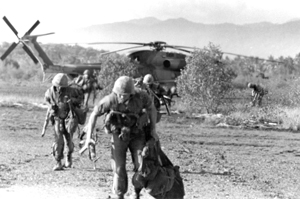 |
Marines scramble from a USAF CH-53 helicopter during the |
Several attempts to turn back the boat, including the use of riot-control agents and shots fired across its bow, failed to stop the vessel. US forces did not attack the boat because of the concern that it held the Mayaguez crew, and the boat safely entered Kompong Som harbor.
On the morning of May 14, the Chairman of the Joint Chiefs of Staff sent orders to US Pacific Command (Adm. Noel A. M. Gayler, commander) and USAF’s 7th Air Force. They were instructed to prepare to seize Mayaguez, occupy Koh Tang, conduct B-52 strikes against the port of Kompong Som and Ream Airfield, and sink all Cambodian small craft in the target areas. Eventually, A-7s from Coral Sea were used instead of the big B-52s.
The planners were handicapped because they did not know whether the Khmer Rouge had moved the prisoners to the mainland or left some or all of them on Koh Tang. The rescuers believed that seizing the island would demonstrate American resolve and result in the release of the crew. Some intelligence specialists believed only a few heavy machine guns protected the island, but the Defense Intelligence Agency and PACOM’s intelligence section warned that US forces would encounter up to 200 soldiers armed with “recoilless rifles, mortars, and machine guns.”
This information failed to reach the marines, who went into battle believing the Koh Tang garrison was defended by roughly 25 irregulars.
Ideally, the island would have been bombed prior to the planned assault, but planners ruled out an air strike for fear of hitting the Mayaguez crew. Instead of dispatching C-130 transports to drop 15,000-pound bombs to carve out landing zones, the planners proposed that helicopters touch down on an open beach to deliver the marines.
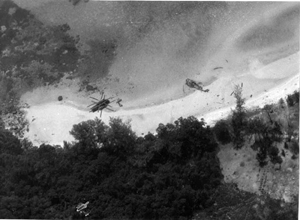 |
The shattered hulks of two helicopters shot down in the rescue mission litter the east beach of Koh Tang. |
The first helicopter took off from U Tapao in Thailand on the morning of May 15. Johnson ordered one marine detachment to board and seize Mayaguez and another battalion to attack Koh Tang. An airborne battlefield command and control center coordinated the aerial activity through a fighter pilot serving as the on-scene commander. The 432nd and the 347th Fighter Wings, Korat RTAB, Thailand, were to provide air support. Forward air controllers would direct the strikes.
Combat operations commenced on the morning of May 15. Three USAF HH-53s brought the attack force to the destroyer Holt, which sailed toward Mayaguez. Next, after a flight of A-7s dropped tear gas on Mayaguez, Holt pulled alongside to release the Marine Corps boarding party, which found no sign of life on the ship. Holt then towed Mayaguez out to sea.
Into the Fire
Meanwhile, at about 6:00 a.m., two Air Force helicopters—Knife 21 and Knife 22—approached Koh Tang’s western beach and two others—Knife 23 and Knife 31—positioned themselves to land marines on the eastern side of the island. The defenses were heavier than anticipated, and the approaching helicopters were met with heavy gunfire.
Knife 21, piloted by Lt. Col. John H. Denham, dropped off its marines and was then hit by enemy fire that caused extensive damage, including loss of its engines. After dropping its external tanks and additional fuel, Knife 21 ditched about 300 yards out to sea. Eventually, another CH-53 arrived and plucked Denham and his copilot from the water.
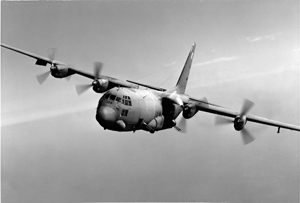 |
AC-130 gunships like this one provided fire power from above for the embattled marines stranded on Koh Tang. |
Knife 22 met a similar barrage, which punctured its fuel tanks. Knife 22 followed Denham’s Knife 21 seaward and eventually made a forced landing on the coast of Thailand, never having inserted its marines.
The same sort of ground fire enveloped Knife 23 as it came over the eastern beach of Koh Tang. Heavy fire knocked out an engine and shattered its tail pylon. All 20 marines aboard made it to the island’s tree line, however, as did the three-man helicopter crew. From there, the copilot used his emergency radio to call in air support.
Knife 31, flown by Maj. Howard A. Corson, similarly ran into furious gunfire. This killed his copilot and forced him to ditch the helicopter in about four feet of water. SSgt. Jon D. Harston helped some of the marines trapped inside to get outside, and then helped several wounded marines stay afloat. Not everyone made it, though. Ten marines, two sailors, and one airman died in the wreckage.
The destroyer Wilson, steaming toward Koh Tang, spotted the airmen and marines from Knife 31 in the water off the eastern beach of the island and moved to pick them up.
The ferocious enemy fire against the first four helicopters prompted the second part of the first wave to hold off. Word from the marines on shore was that they had carved out a small beachhead. The marines soon encountered enemy opposition from defensive positions in log and earthen bunkers and fighting holes. Each fortification was manned by two to four men.
Jolly Green 41 made several unsuccessful attempts to land and finally—on its fourth try—delivered 22 marines. This HH-53 then came down short of U Tapao.
Jolly Green 43 was able to off-load 29 marines who advanced inland to set up a perimeter. Knife 32 was the only one of three helicopters to reach the marine position on the first try. It succeeded in dropping 13 marines, but the damage the CH-53 sustained kept it out of further action after it limped back to U Tapao.
Primary Mission Complete
Of the 180 troops who were to have been off-loaded in the first wave of the assault on Koh Tang, only 131 actually made it to the proper spot. They were placed at three locations, over a three-hour span.
At 9:30 a.m., the pilot of a P-3 patrol aircraft advised Wilson’s captain that a fishing boat was approaching his warship. Wilson held its fire, suspecting that the boat might contain the crew of Mayaguez. It was indeed the Mayaguez crew, which was promptly identified and set free. Both primary missions of recovering Mayaguez and its crew were now complete, but the bulk of the attack force, already heavily engaged on Koh Tang, had no idea that this was the case.
Air support began to improve when an AC-130 special operations forces gunship, Spectre 61, arrived overhead, identified itself to the embedded marines, and fired several spotting rounds—one of which hit an enemy bunker.
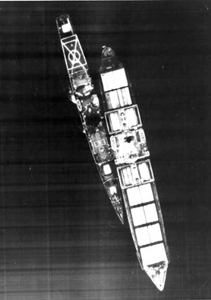 |
USS |
“How was that?” an AC-130 crewman asked, according to the recorded conversation.
“Right on, but it didn’t do much,” the marine replied.
Then the Spectre fired a 105 mm round, which demolished the bunker.
“Jesus Christ,” the marine exclaimed. “What was that? Have I got targets for you!”
The firepower from Spectre 61 and other aircraft enabled two groups of marines to join forces and helped them to survive.
There soon arrived a White House message ordering US forces to “cease all offensive operations” against the Cambodians. That wasn’t in the cards, though. After hearing from his helicopter pilots and others that marines were in place and didn’t control a single landing zone, Burns opted to continue in with the reinforcements.
At about noon, a pair of Jolly Greens successfully delivered 53 marines and picked up some wounded on the western beach. Knife 51 and Jolly Green 43 diverted to the western beach, and they too were able to land their reinforcing marines, increasing the US force to about 200. Knife 51 evacuated five of the wounded.
By now, Coral Sea was within 70 miles of Koh Tang and used its fighters to strike targets near Kompong Som on the Cambodian mainland, thereby preventing enemy reinforcement of the island.
The Last Batch at Last
Supporting fire from the air and sea began to pick up quickly now. The destroyer Wilson began firing on the island. Air Force OV-10 Broncos reached Koh Tang, where they helped to mark targets and aided in the extraction of the Marine Corps force from the eastern beach. A C-130 dropped a 15,000-pound BLU-82 “Daisy Cutter” south of the western perimeter. The bombing probably demoralized the enemy and disrupted a Cambodian attempt to move reinforcements northward to attack the marines.
With the marine contingent now seemingly in a more secure position, the extraction effort commenced at dusk. Two Jolly Greens and one CH-53 were tasked as the initial responders.
Knife 51 was the first to hit the western beach about 20 minutes after sunset. It was able to carry 41 marines out to Coral Sea, which was now just 10 miles away.
The crew of Jolly Green 43 landed the craft seven minutes after Knife 51, and carried out some 54 marines.
Amid an exchange of hand grenades, Jolly Green 44’s landing was delayed because it couldn’t see either the other HH-53 or the beach. After several harrowing passes, it was able to land and extract its marines.
The remaining marines were now protected by fire support from Wilson, an AC-130, OV-10s, and the evacuation helicopters with their multibarrel weapons. Jolly Green 44 returned to the island, where SSgt. Bobby Bounds was able to guide the disoriented pilot and copilot to a safe landing. The helicopter departed with some 30 marines.
Knife 51 was to recover the last batch of marines. It took off from Coral Sea but had to abort two landing attempts because of pilot vertigo. The pilot then turned on his lights, which caused an eruption of enemy fire. The muzzle flashes were spotted by the AC-130 and helicopters crews—Knife 51 was then able to land and, within 10 minutes, evacuated the last marines. They returned to Coral Sea.
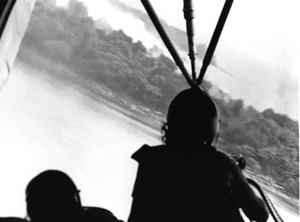 |
A rear door gunner mans his post as an Air Force helicopter leaves the Koh Tang area after the mission. |
The Mayaguez encounter was technically a success, as it safely recovered the American container ship and its crew, but it came at a terrible cost. Forty-one US military personnel died in the operation—including three marines who never made it off the island after the battle at Koh Tang and were listed as missing in action.
On the insertion, most of the helicopters that had taken fire managed to stay airborne long enough to avoid a series of airborne disasters. Later, the marines hung on to their tenuous positions on the island long enough for the Air Force rescue teams to recover and pull them out. A mission that nearly ended in complete disaster was bailed out by the responsiveness, readiness, skill, and bravery of US military units.
| The Heroes of Mayaguez
For their heroism during the Mayaguez operation, Air Force helicopter crewmen and forward air controllers were awarded 92 medals. This included four of the just 10 Air Force Crosses that have been earned since Vietnam. Air Force Cross recipients were:
First Lt. Richard C. Brims, the pilot of the CH-53 Knife 51. Brims and his crew extracted 70 marines from Koh Tang, including the last group, which was rescued after dark and under tremendous enemy fire.
SSgt. Jon D. Harston, a flight mechanic aboard Knife 31, which was shot down into the water. Harston, shot in the leg, was in about four feet of water when he returned for his M16 and helped several marines through the flames to safety. He pulled two injured marines to deeper water where the survivors were rescued by USS Wilson.
Capt. Roland W. Purser, pilot of the rescue helicopter Jolly Green 43. Purser made repeated runs to the heavily defended island over the course of 16 consecutive hours, and during one sortie brought out 54 marines.
|
